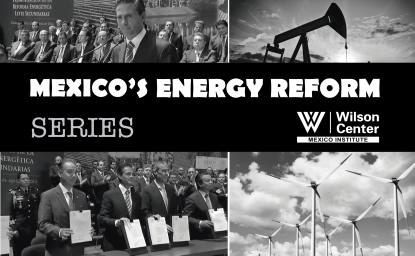North America is fast becoming the epicenter of a transformation in global energy. Canada, Mexico and the United States are bringing to market huge new energy resources that were too expensive or politically risky to exploit until recently. According to the Energy Information Administration, North American oil and gas growth is expected to exceed all of OPEC's over the next decade.
But despite North America's huge energy potential, the United States, Mexico, and Canada all face serious obstacles in getting their energy resources to market. Skills gaps and low public support for energy infrastructure stand in the way of a potentially rich North American energy future. As the three North American energy ministers prepare to meet in Washington on December 15th, they must develop innovative policy solutions to overcome these barriers and create the necessary support structure to fully realize North America's emerging energy boom.
The United States has already seen its oil production skyrocket in the last six years from around 5 to 8.6 million barrels per day (mbd). It is the world's top producer of both oil and natural gas. The Canadian Energy Research Institute forecasts that Canadian crude oil production will nearly double in the next fifteen years from around 2 mbd in 2008, to 3.5 mbd today to 6.7 mbd by 2030. In Mexico, conservative estimates predict that recent reforms will increase Mexico's oil production by a staggering 75 percent.
But being blessed with energy abundance does not necessarily beget energy production.
Mexico will need $8 billion in infrastructure investment to get its energy to market. Its crude oil pipeline system is aging and requires significant attention. Its 3,000 miles of pipelines pale in comparison to the 57,000 miles of pipelines in the United States. Canada's lack of energy infrastructure is costing that country tens of million dollars every day. The United States requires more than 15,000 miles of transmission to meet growing demand. According to the American Society of Civil Engineers, "ongoing permitting issues, weather events, and limited maintenance have contributed to an increasing number of failures and power interruptions." What's more, a lack of pipeline capacity has forced more oil onto the rail network in the United States, doubling traffic in teh last five years, raising safety concerns, and squeezing out commodities such as grain that have traditionally been moved by rail.
Even if new infrastructure projects are approved, they require human capital that is lacking in all three countries. Developers in the Albertan oil sands are looking to the United States for needed engineers, pipefitters and electricians. But the United States is itself under-supplied in these very fields, as is Mexico. In fact, a recent Mexican government study estimates that the country needs more than 136,000 engineers, technicians and other qualified personnel to meet the demands of its energy reform.
And even if the infrastructure can be built, will the public support it? The bruising fight over the Keystone XL pipeline demonstrates the difficulty in winning public support for energy infrastructure. Projects regularly take years to approve; Keystone is not unique. Everyone wants to use energy, but no one wants it transported across their backyard. And it does not make much of a difference if the energy is produced from fossil fuels or renewable sources. In one recent example, Iowa farmers are opposing new transmission lines needed to bring wind energy from the northwestern part of Iowa to the population centers in the southeast because it crosses their farmland.
The energy ministers from Canada, Mexico, and the United States have their work cut out for them when they meet in Washington, DC next week. Given these challenges, it is imperative that they work towards innovative policy responses by:
1. Planning energy infrastructure projects that respond to regional supply and demand needs and that will help to integrate energy markets across the region;
2. Protecting critical infrastructure through a concerted effort, involving energy and security agencies;
3. Confronting the human capital crunch and skills gap facing the energy industry by working together and with the private sector to design curricula and programs that will train the next generations of workers required by the energy industry.
Notwithstanding the nearly 40 percent price drop in oil prices over the last few months, today's lower prices are still high enough to invite North American investment, exploration and production. The sector has shown in recent times that lower prices can drive innovation that in turn lowers production costs. However, investments must start with public sector support for the infrastructure and human capital necessary to bring these resources to market.
While enormous attention has focused on North America's energy potential, it is infrastructure and human capital that will play a central role in making the potential abundance a reality and shape the economic future of each of the three states. Focus on the key agenda items articulated above will be crucial to converting North America's energy abundance into tangible benefits for its economies and people.
Rachel Bronson is a Senior Fellow for Global Energy at The Chicago Council on Global Affairs. Duncan Wood is the Director of the Mexico Institute at the Woodrow Wilson International Center for Scholars.
This article was originally published on Forbes.com



